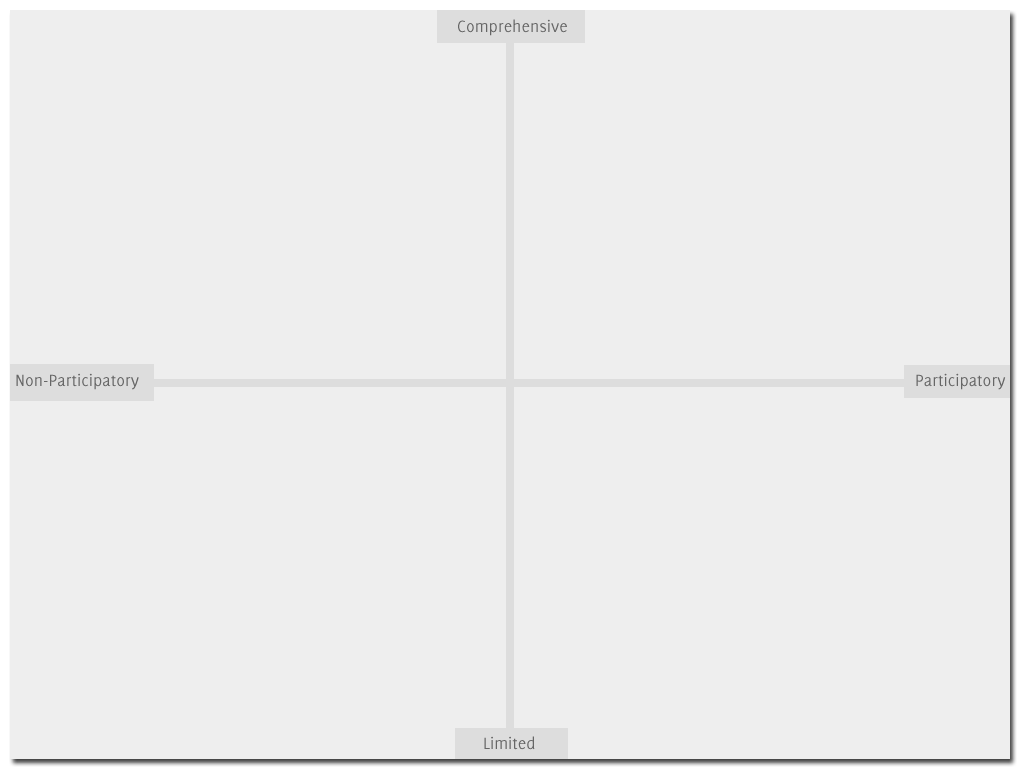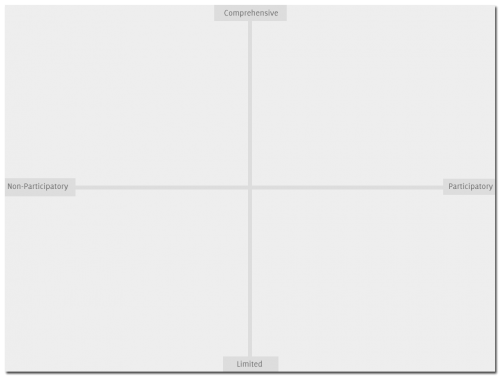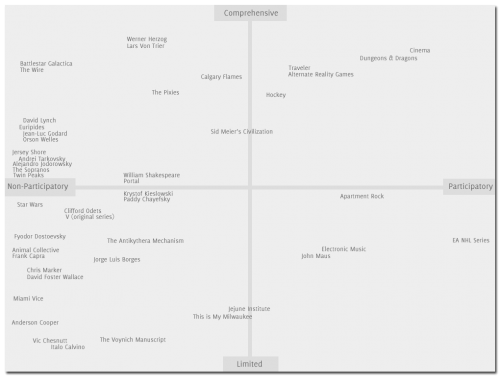This paper visualizes a sample of my own fan practices by placing them on a simple x/y grid. Based on this visualization, I draw a variety of provisional conclusions regarding a) the role of fandom in my life in general; and, b) its relationship to my artistic practice in particular. Finally, I conclude with a brief commentary on the future of fandom in the context of network culture.
The Grid
This is a blank version of the grid I created for this exercise (larger view). The horizonal axis represents the degree to which a particular practice is participatory, with the rightmost end of the axis representing a maximally-participatory level of engagement. Individual practices are positioned on this axis based on how I answer questions such as:
- Did my fandom lead me into actively engaging with an intellectual property’s (IP’s) broader fan community?
- Did my enthusiasm for a media franchise or category result in me attending conferences, connecting with others online, and participating in other events, or did I let such opportunities pass me by?
- Did I engage with the world of the IP to the point where I began to produce my own extensions to that world?
- And finally, did my fandom lead me closer to an “active” community of practice, or did I remain within the confines of a more “passive” community of spectatorship?
The vertical axis of the grid maps the degree to which a particular fan practice is “comprehensive,” and addresses the following kinds of questions:
- Did my commitment to the IP or category make me want to accumulate everything that I could get my hands on related to that franchise or practice?
- Did I become an obsessive collector of related information and media, or was I content to merely sample smaller portions of the world of the IP?
- Did I gravitate toward an “expert” level of knowledge? Or was I happy to remain on the surface in terms of my apprehension of the totality of the world of the IP?
The Rules
I set out some simple rules for myself to limit the size of my sample and to render the visualization as useful as possible. First, I decided that there should be no limitation to a particular period in my life; rather, I would plot fan activities from across the the full 36 year spectrum of my existence in the hopes that I might discover certain commonalities and tendencies that transcend age and context boundaries. Consequently, I found it necessary to invent a second rule, namely, that the plot on the chart should represent the point of my maximum involvement in a given fan practice. To do otherwise would have meant introducing moving plot points to reflect the rise and fall of my interest in a particular IP or category — which, let’s face it, would be super-cool, but in the absence of an easy-to-use tool to do just that, designing an animated interactive chart lies beyond the scope of the present sketch. Finally, to keep the size of the sample from ballooning beyond manageability, I limited myself to a single 10 minute brainstorming session during which I would attempt to think of all the fandoms that I consider myself to be a part of.
The Sample
This list shows the result of my brainstorming session. After writing the list (which is incomplete and potentially embarrassing — looking over it now, I realize I have left out about a dozen of my absolute most favorite things) free-hand in my notebook, I then entered it into my text editor and sorted it alphabetically. This is what I got:
- Alejandro Jodorowsky
- Alternate Reality Games
- Anderson Cooper
- Andrei Tarkovsky
- Animal Collective
- Apartment Rock
- Battlestar Galactica
- Calgary Flames
- Chris Marker
- Cinema
- Clifford Odets
- David Foster Wallace
- David Lynch
- Dungeons and Dragons
- EA NHL Series
- Electronic Music
- Euripides
- Frank Capra
- Fyodor Dostoevsky
- Hockey
- Italo Calvino
- Jean-Luc Godard
- Jejune Institute
- Jersey Shore
- John Maus
- Jorge Luis Borges
- Krystof Kieslowski
- Lars Von Trier
- Miami Vice
- Orson Welles
- Paddy Chayefsky
- Portal
- Sid Meier’s Civilization
- Star Wars
- The Antikythera Mechanism
- The Pixies
- The Sopranos
- The Voynich Manuscript
- The Wire
- This is My Milwaukee
- Traveler
- Twin Peaks
- Vic Chesnutt
- V (original series)
- Werner Herzog
- William Shakespeare
The Plot
The next step was to plot each item onto my grid by asking myself the questions outlined above:
While the process here is obviously unscientific, the aggregate effect is nonetheless a reasonably good sample portrait of my fan practices. As I plotted each item onto my grid, I began to notice certain patterns emerging. For example, the bulk of my brainstormed fandoms settled along the leftmost edge of the chart. These fandoms were differentiated from one another by my level of expertise (or “comprehensivity”), but all shared a distinct lack of participatory engagement (at least in terms of commonly-held notions about what constitutes participation, such as conference-going, fan club membership, online forum activity, and so on). The remainder of the chart was populated by small clusters of interests which represented my more socially-engaged forms of fandom. Interestingly, there appeared to be little correlation between social engagement and expertise. at least in terms of expertise being a pre-requisite for participation; that is, it seemed just as likely (or, at least, almost just as likely) that I would be “expert” in something that I didn’t actively participate in as it was that I would participate in something that I had only limited knowledge of.
Having plotted the chart and conducted a preliminary analysis, I then proceeded on to a more in-depth look at the contents of the four quadrants.
The Four Quadrants
Non-Participatory, Non-Comprehensive
This is the most casual of the four quadrants. My fandoms here are typically born of simple affection. Anderson Cooper, for example, is just someone from whom I’ve gotten used to getting my daily dose of CNN; I consider myself a “fan” not only because I think he is the most well-informed of a crop of decidedly out to lunch major network broadcast personalities, but because he occasionally enacts a kind of earnestness that I find believable for whatever reason. I focus on Cooper here because his is probably the least participatory fandom represented on this chart: for a variety of reasons, I just don’t see myself ever feeling the need to get any deeper into the community around AC360 than I already am. My involvement with this “IP” is essentially limited to watching Cooper on TV and clicking on news reports or blog posts that provide information about his life — and I’m fine with leaving it at that. What’s interesting here is that there are several fandoms listed about which I know even less than I do about Cooper — for example, I have seen the inside of Anderson’s apartment via various random web happenstances, while I’m pretty sure I’ve never come across so much as a picture of Italo Calvino (well, now I have…) — but with which I have been more engaged in terms of participation. Calvino, for example, I know only through two of his books — If on a Winter’s Night a Traveler, and Invisible Cities; but in the course of creating some mobile phone artworks last year, I produced an SMS-based collaborative storytelling project using snippets from Invisible Cities, which brought Calvino into the purview of a group of participants who might have otherwise never heard of him. While this engagement might not be within the boundaries of a traditional definition of “fandom,” I believe that at the very least it entitles Calvino to a spot on my chart a little bit to the right of Cooper. The same goes for the Voynich Manuscript, another oddball kind of fandom that I have placed even further along the continuum toward participation. While I know basically nothing about the mysterious manuscript — indeed, few people do, which is what makes it so interesting — I have taken the time to blog about it a little, and have pointed to it in other fora, including on Alternate Reality Gaming boards and Twitter. More recently, I have joined in on the discussion around the manuscript raised by its recent coverage on xkcd. Clearly, the amount I know about a given IP or practice does not necessarily reflect the degree to which I participate in that community’s fandom.
For me, the relatively passive fandoms of the non-participatory, non-comprehensive quadrant occupy the least amount of my time, and are in many senses the most easily-retained of my fan practices. Is this because the media properties in this quadrant somehow ask less of me? Or is it more a matter of me simply choosing not to get involved? My sense is that it is a combination of these two things. Some media properties do in fact inherently demand participation — World of Warcraft, for example, is almost unavoidably participatory. Other IPs or categories are more flexible. In general, those IPs and categories in the non-participatory, non-comprehensive quadrant must be in this latter group of flexible fandoms, for otherwise they would of necessity be located elsewhere on the grid.
Non-Participatory, Comprehensive
Moving upwards from the non-participatory/non-comprehensive quadrant, we move away from simple “messing around” and closer to “geeking out” (although, to be precise, full-on geeking out necessitates a degree of participation that will only emerge once we move into the quadrants explored below). This is the domain of much of my expert-level knowledge, such as that gained from my exhaustive back-to-back viewing of all five seasons of The Wire, supported by ancillary research on Baltimore, biographical research on the show’s performers, and even the printing of a t-shirt bearing the face of Omar Little (beneath which my girlfriend printed the text, “Indeed”).
The Wire sits along the left side of this quadrant with other properties and categories of which I would identify myself as a fan — which, as with the non-participatory fandoms in the previous quadrant, raises the not insignificant question of, well, what’s a fan anyway? To this I answer that to be a fan is to be on a continuum. While I have never participated in fan clubs, conferences, online fora, or the myriad other social activities that exist around the properties and categories in the leftmost portion of this chart, the fact that I’ve placed these things onto the chart at all indicates that on some level I feel a connection to the social structures that support and give life to them.
Some of the most interesting points on this chart are those that exist in the interstices. Two items from the (arbitrarily imposed) border between the non-participatory/comprehensive and participatory/comprehensive quadrants deserve brief note in this regard. First, the Calgary Flames: this is the hockey team I’ve followed since childhood, and as far as me and my friends are concerned, I know just about everything there is to know about the team. That said, my engagement with the larger fan community through websites such as Matchsticks and Gasoline has taught me that no matter how much I think I know, there’s always more to learn — a lot more to learn. This reveals an interesting phenomenon: as one moves deeper into participation, the notion of what it means to have “comprehensive” knowledge changes. Prior to my encounter with the online fan community, I got all my Flames news from the Calgary Herald, Yahoo! Sports and so on. Now, I realize that there is a whole underground world of independent sports analysts, girls who go to the rink to watch the team practice and listen to the coach, guys who hang around the parking lot after games to eavesdrop on the players’ conversations, and more. That is, getting involved in the community gave me a better sense of what I didn’t know as much as it opened vectors for me to learn and share.
Participatory, Comprehensive
Just on the other side of the border line between the top two quadrants is the category of hockey. In general, I am a huge hockey fan. I know less about hockey as a whole than I do about the particular “IP” of the Calgary Flames, but my involvement is much greater. For example, when I lived in Toronto, I participated in an artist-run hockey league, organizing a team that competed in dozens of games a year and put on a good show at the annual “Hootenanny,” a celebration of hockey and rock n’ roll that is probably only possible in Canada’s largest city. Here we see a fandom that has fully transitioned into the realm of the participatory; here we see my passion for the puck and music engaging directly with a community of like-minded others…
Fandoms in this quadrant require the most passion and dedication; indeed, many of the fan practices listed here in fact have become careers for me — my love for the cinema led to a career as a screenwriter and story editor, and my deep interest in role-playing games and improvisatory storytelling led me down the path that I presently walk, along which I have discovered such inspirations as alternate reality gaming (itself now a closely-held fandom). While distinctly non-casual, these kinds of fan practice are among the most rewarding activities in my life; so much so that I wonder if the word “fan” can and should still apply. Is the continuum of fandom in fact a part of a larger continuum, one which is ultimately inseparable from the desires and impulses of our deeper selves? Should we reconsider the word “fan” — or, conversely, apply it more broadly?
Participatory, Non-Comprehensive
My initial thought when I conceived of this grid was that this quadrant would be more or less empty. To my surprise, it ended up being almost as full as the participatory/comprehensive quadrant — and with a more complete sample set, I expect it would actually exceed it quite substantially. Indeed, on further reflection, I would like to suggest that in the future, this quadrant will be by far the most heavily-populated kind of fandom — that is, if “fandom” continues to be a useful category, which itself is something I have questions about.
The participatory/non-comprehensive quadrant contains activities that take place in inherently networked situations. Apartment rock is a part of a long tradition of shared mix tapes, crude recordings passed from hand to hand — a tradition that is now greatly expanded and accelerated by the Web and social media. The same goes for electronic music, exemplified by artists like John Maus, of whom I am both a fan and a remixer. Finally, at the rightmost extreme of the chart, we find an online video game — EA’s NHL 10 — that I play exclusively with others; in this case, my affection for the video game is inseparable from the act of participation — the sharing of points, the trash-talk in the lobbies, the intense team play that requires getting to know other players in order to win… Even though I don’t know that much about the game — there are others who clearly know 100 times as many tricks as I do, secret ways to fool the goalies, set defensive plays that produce breakaways, and so on — simply by virtue of playing, I am participating. I believe such intrinsic relationships with participation will be the future of fandom.
Final Word
Plotting a sample from my own fan practices on a Cartesian grid measuring degree of participation against degree of comprehensivity reveals that my fan practices shift depending on the form and context of the media artifacts they focus on. Key discoveries include insights into the new kinds of fandom brought about by the fundamentally participatory nature of online multiplayer gaming; a vision of the continuum of affinity and practice to which fandom belongs; and an acknowledgement of the inherent connection of even the most passive fan practices to active communities of fandom.
Readers are invited to download their own blank charts, onto which they may place their own fan practices. Blank charts can be downloaded here. Send one to me if you like!



Pingback: IMAP | Daily Digest for January 25th